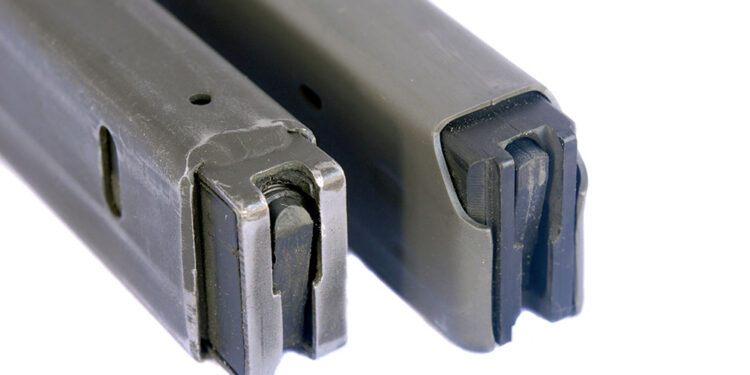By Frank Iannamico
The new .22 rimfire caliber conversion kits by Subgun Ordnance for the Uzi submachine gun were reviewed in SAR Volume 13 Issue 2. Since that article appeared there have been several new innovations and enhancements introduced for the popular kits and an on-line trouble-shooting guide for those kits that may not run 100-percent in a particular Uzi. There have also been a number of new related products and services introduced to the market.
While the concept of a .22 caliber rimfire machine gun sounds very appealing, due to the diminutive cartridge’s straight rimmed case and inconsistency of manufacturing tolerances, designing a reliable, rapid firing full-auto weapon, and accompanying magazine is not easy. The forgiving design of the 9mm Uzi submachine gun, which gives the weapon its legendary reliability, is the same reason it’s difficult to convert it to .22 rimfire. There is little margin for error when attempting to get a submachine gun to function reliably with .22 caliber rounds.

A Brief History of the .22 Caliber Uzi Conversion Kits
In the past, .22 caliber conversion kits for the Uzi have been manufactured by Israeli Military Industries (IMI), Action Arms, Group Industries, Vector Arms and more recently, the Barrelxchange and Subgun Ordnance. Group and Vector made several variations of their full-auto kits, most having only moderate success. However, despite having a known reliability concern, today the kits, and their accompanying .22 caliber magazines, are sought after by collectors. One thing that most of the kits had in common was they required some tuning to be functional.
When the first semiautomatic Uzi carbines were imported into the U.S. during the 1980s by Action Arms, Ltd. of Philadelphia, one of the many accessories offered was a .22 caliber conversion kit made in Israel by IMI. The kits came with a two-piece .22 caliber steel bolt, a six-inch barrel liner for insertion into the 9mm barrel, and two steel .22 magazines. A .22 conversion kit was also offered for the Uzi submachine gun, but few kits were sold and are quite rare today. The bolt for the submachine gun kit was marked SMG, the bolt for the semiautomatic kit was marked carbine. Later Action Arms introduced their own .22 caliber conversion kits that had a steel bolt inside of a plastic housing, and came with a complete barrel, instead of a barrel liner. The kit came with two plastic magazines and a loading tool. The retail price of the kit was $159.
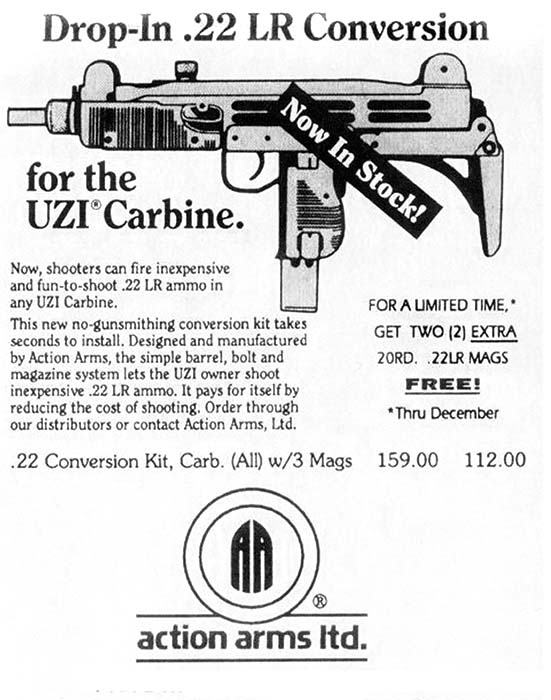
Group Industries was a well-known name among Uzi enthusiasts, first for their IMI Uzi carbine conversions to select-fire submachine guns, prior to May 1986, and for their conversion parts for the semiautomatic carbines, at a time long before “genuine” Israeli Uzi parts became common. Later, Group Industries began to manufacture their own “U.S. Made” Uzi receivers and parts. Unlike converted semiautomatic IMI Uzi carbines, the Group Uzis were made to submachine gun specs, with all parts: sears, barrels, trigger housings and bolts completely interchangeable with original factory IMI Uzi submachine guns. Group Industries also offered a .22 conversion kit for semiautomatic and select-fire Uzis.
The Group Industries early .22 conversion submachine gun kits were similar to IMI’s semiautomatic conversion kit, having two springs and a two-piece steel bolt. The two springs made the unit difficult to cock, and it had a very fast cyclic rate (when it worked). Group later modified the original design using an aluminum bolt, also having a separate firing pin that was actuated as the bolt closed on the chamber. The third Group conversion was further modified to be more reliable. This variation used a one-piece aluminum bolt with a fixed steel firing pin, a steel insert to contact the weapon’s sear surface and a single recoil spring. Group’s third .22 kit design, was far more reliable than the previous two. As production continued, the feed ramps on Group Industries’ barrels were reconfigured a few times for improved feeding. Barrels were configured to fit the semiautomatic carbine with restrictor rings or submachine gun receivers without them.
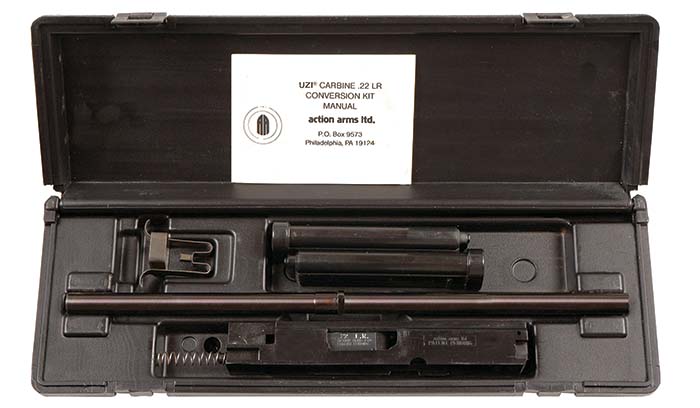
Vector Arms
After Group Industries went out of business, many of their unassembled Uzi semiautomatic and submachine gun receivers were procured by Vector Arms and eventually assembled into functional firearms. Vector also produced several variations of the .22 conversion kits for the Uzi. The early Vector conversion kits were similar in design to the late Group kits with an aluminum bolt and a fixed steel firing pin. Early kits sometimes experienced interference with the 9mm ejector, resulting in Vector including an instruction sheet on how to modify it. Later production Vector kits were upgraded by modifying the bolt to clear the ejector, and a new recoil spring. The instruction sheet also mentioned that the kit should work with the 9mm spring assembly, but a weaker spring was included if problems were encountered with the original spring. The instructions recommended the use of high-velocity Winchester or Remington .22 ammunition. The feed ramps on later production Vector barrels were widened to improve reliability.
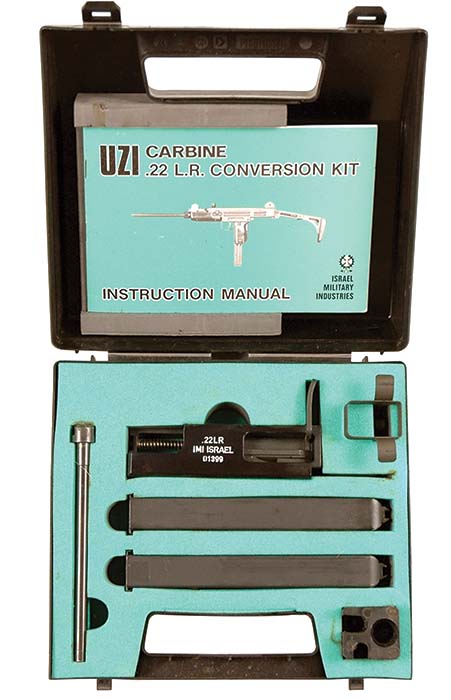
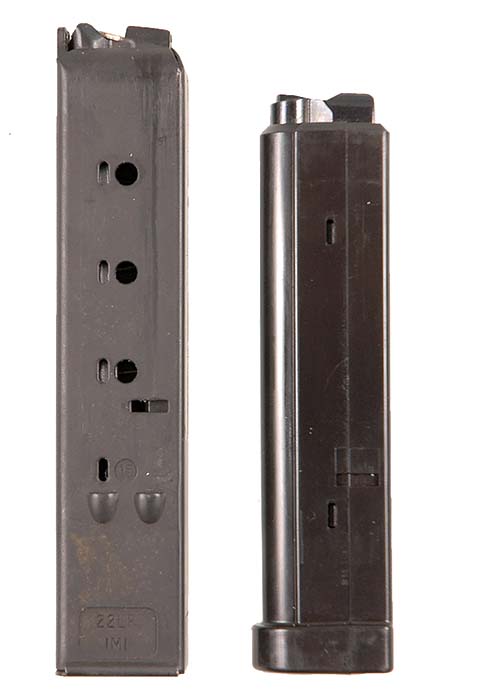
Group Industries Magazines
The Group Industries .22 caliber magazines were fabricated using original Uzi 25-round magazines bodies. A two-piece aluminum insert and follower were used to adapt the Uzi 9mm magazines to accommodate the smaller .22 rounds. The follower used two springs to feed cartridges, a primary long spring and a stiffer short spring positioned underneath it. Several round “witness” holes were drilled into the body and inserts so the operator could see how many rounds were in the magazine. The feed lips were formed on the aluminum inserts. Later production magazines used the same aluminum inserts and follower with the dual-springs, but the feed lips were made of steel and welded onto the top of the magazine body. Later magazines only had one witness hole to indicate when the magazine was loaded to capacity.
Vector Arms .22 Magazines
The early Vector magazines, marketed in 20- or 28-round configurations, were similar to the later Group Industries design, using steel 9mm Uzi magazines with aluminum inserts and followers for the .22 cartridges. Later Vector Arms began to use plastic inserts and followers. Some of the later Uzi magazines offered by Vector were of unknown origin and had a slightly longer body length than the originals, were used for the conversions. Reportedly these magazines will not readily fit into some Uzi magazine wells.
With the Uzi submachine guns becoming increasing popular in the last few years, there has been similar interest in spare parts and accessories. The Group and Vector Arms .22 conversions and their steel magazines have become popular, particularly since the escalating cost of 9mm ammunition. Now out of production, and not especially common, the .22 conversion kits and their steel magazines have become sought after by collectors, and accordingly expensive.
There is little doubt that a market existed for a .22 conversion kit for the full-size Uzi SMG, and Subgun Ordnance of Racine, Wisconsin decided to fill the need, introducing their .22 conversion kit in 2009. Subgun Ordnance’s kit consists of a .22 caliber barrel, bolt and a plastic magazine manufactured by Black Dog Machine LLC. Like the Uzi was originally designed, the .22 kit fires from an open bolt, and functions in both semiautomatic and full-automatic modes of fire. The conversion kits are designed for select-fire Uzis only and will not fit or function in semiautomatic-only versions, or conversions that have the receiver-blocking bar in place.
The 32-round magazines that were chosen for inclusion with the Subgun Ordnance kit are an existing item being manufactured by Black Dog Machine LLC originally designed for the Vector manufactured .22 Uzi conversion kits. The magazines are a double stack, single feed design manufactured from polycarbonate to form the magazine body; they have a slight curve to compensate for the rimmed .22 cartridges. The follower and floor plate are made from plastic and have a steel coil-type follower spring. No magazine adapter is needed; they fit in the standard Uzi mag well. The magazines are inexpensive and readily available.
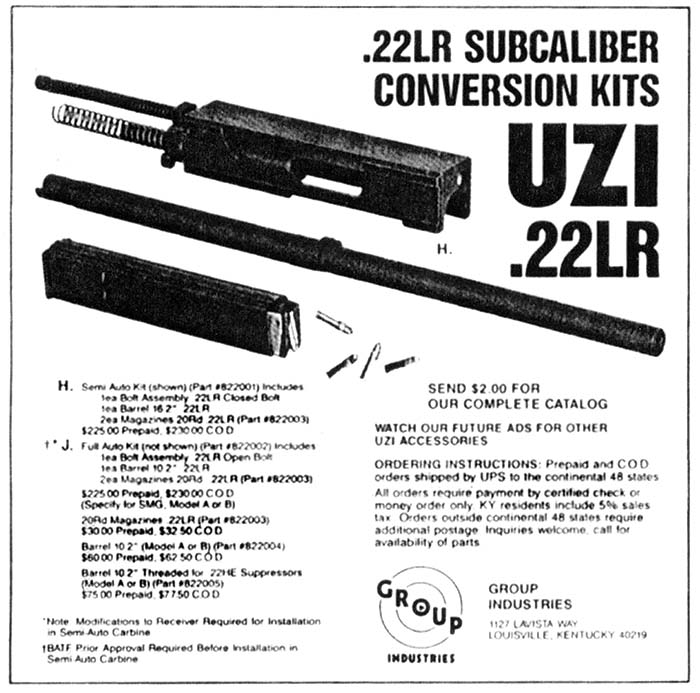
The Barrelxchange
Most of the .22 conversion kits for the Uzi are for the full-size model. However Troy Edhlund of the Barrelxchange has manufactured a conversion for the semiautomatic and select-fire Mini- Uzi and is introducing a new Universal Model that will fit the full size, mini or the Uzi pistol. The new kit is an updated/improved version based on the original IMI .22 conversion kit that is charged by the original top-cocking handle; the new kit comes with a modified Black Dog magazine. The Barrelxchange also makes .22 caliber replacement barrels for the IMI, Vector Arms and Subgun Ordnance kits, and offers a tune-up service for problematic .22 conversions and magazines.
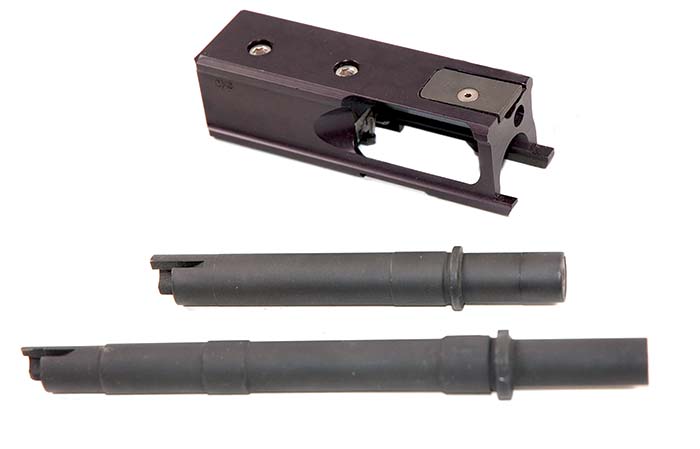

The BWE .22-Uzi Slow-Fire Enhancement
BWE Firearms
Richard Hoffman of BWE Firearms specializes in the Uzi with a particular interest in the .22 conversion kits. One of his latest innovations is the slow-fire upgrade service for the .22 Uzi. The top of the customer’s .22 aluminum bolt is milled out and a steel weight inserted and attached by Allen screws. The increased mass of the bolt along with his custom-tuned spring assembly is able to closely duplicate the original cyclic rate of a 9mm Uzi with no loss of reliability. The service is currently offered only for existing customer’s conversion kits.
As designed, the Subgun Ordnance .22 conversion kits have a cyclic rate of 875 to 900 rounds per minute, rather fast, but many shooters feel it is ideal. Others have expressed a desire to have a slower cyclic rate similar to that of the standard 9mm Uzi, approximately 600 rounds per minute. There are several reasons for reducing the cyclic rate of the 22 kits, one is to experience the original feel of the 9mm Uzi, extend the length of time to “dump” a magazine on full-auto, and another is to conserve ammunition.
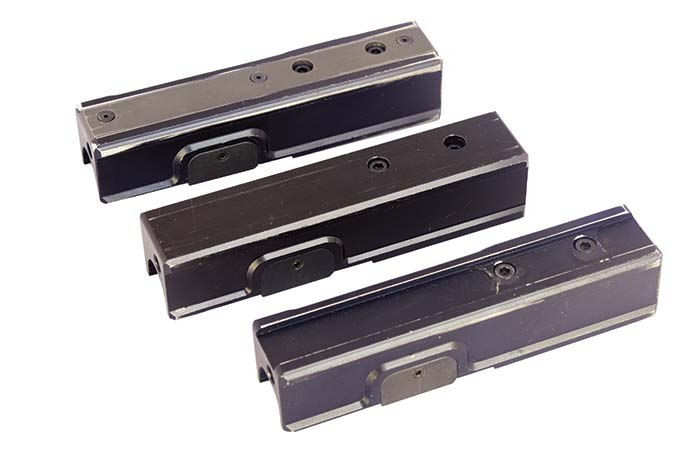
The Group Industries and Vector Arms .22 conversion magazines using original Uzi steel 9mm magazine bodies are highly desired items, but they were not manufactured in very large quantities. During Group Industries and Vector production, original Uzi 9mm magazines were not as prolific or inexpensive as they have become in recent years, which limited their use for conversion to .22 caliber. Today, the original steel conversion magazines are very hard to find and can be quite expensive.
Aware of a ready market for steel .22 magazines, BWE Firearms decided to develop and market new ones. The 28-round magazines are made from original Uzi magazine bodies modified for use with .22 caliber ammunition by the addition of a two-piece Acetal Copolymer (plastic) insert and follower. The feed lips are machined right into the inserts eliminating alignment issues. The inserts are fitted to each steel magazine body. The magazine’s steel bodies are Parkerized in a smooth gray-green finish, giving the magazines a factory new appearance. The completed magazines are then tested for proper function. Currently under development at BWE is a 12-round extension to increase magazine’s capacity to 40-rounds.
BWE also offers custom tuning of .22 conversion kits that may not function to the customer’s satisfaction, and offers a full line of parts and shop services for the Uzi.
One downside to .22 caliber full-automatic firearms is that it usually takes a lot longer to load the magazine than it does to empty it. To make the task of loading easier, Ken Christie of Christie Products, offers a magazine loader specifically designed for .22 Uzi magazines, and works with both the Black Dog plastic and BWE’s new steel magazines. The tool not only makes loading easier, using the loader stacks the cartridge orientating the rims of the .22 cases in the correct order. If the rim of the top cartridge gets loaded with its rim behind the rim of the round under it, a malfunction due to “rim-lock” is sure to occur. During initial testing of the Subgun Ordnance .22 conversion kits, it was discovered that loading the magazine with the aforementioned loader greatly enhancing the magazine’s feeding reliability.
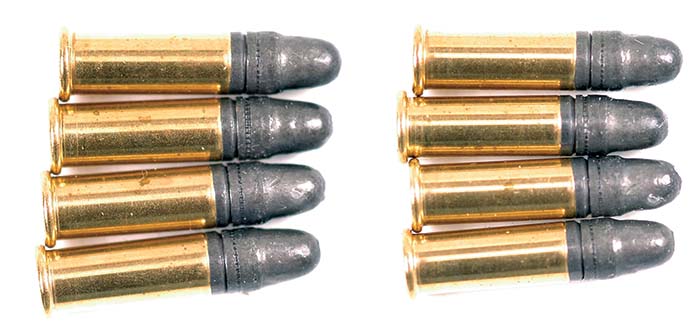
Uzi online resources:
www.barrelxchange.com/
www.bwefirearms.com/
www.Uzitalk.com/forums/index.php
www.Subgun-ordnance.com/
www.Uziparts.com/
| This article first appeared in Small Arms Review V18N1 (February 2014) |



